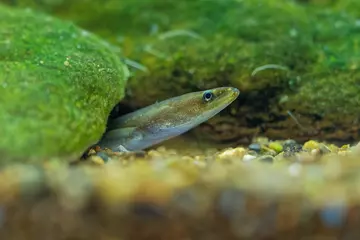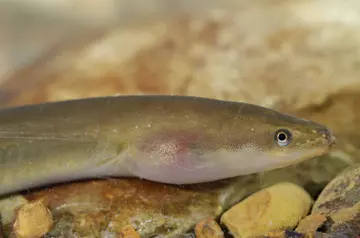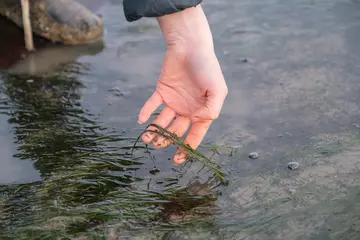At ZSL, we know that conservation works best when it's powered by science. From uncovering their secret breeding grounds to making 189 hectares of habitat accessible with eel ladders, together with our partners we're restoring Critically Endangered European eels across the UK.
Eels in the UK
European Eel lifecycle
Glass eels
When European eels arrive in our rivers they’re just 8cm long and transparent, but they’ve already travelled 6,500km. That’s because all eels hatch from eggs in the Sargasso Sea, an area of the North Atlantic Ocean. They spend the first year or two of their underwater life as larvae, floating towards Europe on the ocean currents, before transitioning into glass eels as they reach European waters.

2. River migration
Having survived their mammoth voyage and arrived in the Thames Estuary, glass eels begin transitioning into elvers – up to 12cm long and a dark brown colour.
They journey up the Thames and into our system of tributary rivers, looking for a home where they can feed on insect larvae, crustaceans and other fish. The Thames River system is highly fragmented, and the elvers face over 2,000 barriers to their migration, like weirs and dams. We install specially built eel passes to help them access areas of rivers that have been cut off to them.

3. Becoming a yellow eel
Once they’ve found a safe spot to feed and grow, the elver begins the next part of their lifecycle, becoming a yellow eel (named because of their yellow tummies). They can spend 20 years in our rivers, feeding and growing up to one metre in length and weighing up to 6kg – that’s about the same as a domestic cat. It’s also at this stage when they’re most likely to be affected by pollution in our rivers, like sewage leaks.
4. Eel breeding
All of their hard work over the last few years has been leading up to this moment: the eel makes its final transition into an adult silver eel. Their silver colour will help camouflage them from the countless predators they will face on the return journey to the Sargasso Sea. The adult eel will now need all the weight and strength it’s built over the last decade or two to swim 6,500km to their birthplace. For eels that do survive the migration, they achieve their ultimate goal: the chance to breed with other eels and lay their own eggs.
European eel Conservation in the River Thames
European eels once thrived in London’s rivers but the number of young joining the adult populations has dropped dramatically since the 1980s and the species is now classified as ‘Critically Endangered’ by the IUCN Red List of Threatened Species. Our work on European eels started in 2005 and now ranges from informing international conservation policy and leading UK research on eel behaviour to regional-scale best practice conservation delivery in the Thames Catchment. Through research, river improvements, public engagement and advising policy, we work in partnership with the Environment Agency and a network of other organisations to address the key conservation issues facing eels.
Eel scientific research
Until 2022, no one was sure where European eels came from. It had never been proved that eels bred in the Sargasso Sea. Our scientists cracked the case by catching adult eels in the Azores and fitting them with satellite tags. We were able to watch the eels return to their mysterious breeding grounds in the Sargasso Sea.
Reconnecting broken migratory pathways
A principal conservation action for eels in freshwater is to restore migratory pathways by removing barriers such as weirs. If removal is not possible, the impact of barriers can be partially mitigated by installing eel passes that allow eels to move upstream over them. With over 2000 barriers to migration, the Thames rivers are highly fragmented. One of ZSL’s key goals in the region is to reconnect migration routes. So far, eel passes commissioned by ZSL have made 138.95 hectares of additional habitat accessible.

Assessment of Adult European Eel Stocks in the Thames River Basin
We've monitored the recruitment of juvenile eels into the Thames River Basin since 2005. The data collected to date supports the findings that the annual recruitment of the European eel across its range has reduced by 90-95% since the 1980s. It is likely that this reduction in recruitment will have had an impact on the numbers of adult eel in the Thames River Basin. In 2019, our repeated surveys of adult eels undertaken in 1987 and 2011 to assess the geographic spread of eel populations in the Thames and identify the effect of the range of measures that have been introduced to improve eel stocks.
Thames Eel Management Plan
We're a key partner in delivering the Environment Agency’s Thames Eel Management Plan. The management plan outlines key targets and measures to improve the population and conservation of the European eel. Given the scale of the challenges faced by eels, working together is essential – if you or your organisation would like to join us in this work please get in touch.
ObstacEELS
We are working with partners in the Thames Rivers Trust Thames Catchment Community Eels Project to co-develop a standardised methodology for citizen science river walkover surveys with the aim of mapping barriers and assessing their impact on upstream eel migration. The barrier assessment method will be based on the EBAT scoring system and data captured using the River Obstacles App, which ZSL worked in partnership to help relaunch in 2021. This is an exciting development which will help fill data gaps on where barriers are in our rivers nationally and help river Catchment Partnerships make decisions about how to prioritise conservation action for eel and other fish species by restoring source to sea habitat connectivity.
The importance of marshes to European eels
Eel predators
Eels are an important food source for the UK’s other wildlife, like otters, bittern, osprey and herons. They also scavenge on decaying matter, keeping our rivers healthy.
How far do European eels migrate?
Eels migrate 13,000km during their lifetime. That’s like swimming from London to Edinburgh 20 times!

Eel ladders
Eel passes are also known as ladders, because they contain grooves or bristles that help the eel climb up them and into the
river beyond. Our scientists are working on the ultimate eel pass. It involves presenting different ladders to eels in our labs at London Zoo, filming their ascents, and using AI to process the results. No eels are harmed – we return the eels to the river after they have attempted one ascent.
How can you help?
From March to June each year, ZSL and project partners recruit citizen scientists at sites across the Thames region to help check eel traps and measure and release any eels present. This gives us data on the number of young joining the adult population and can highlight the impact of barriers, one of the principal threats to eels in freshwater.
In 2018, ZSL produced a field guide for assessing the 'passability' of man-made river structures by European eels entitled the Eel Barrier Assessment Tool (EBAT). This step-by-step guide has been designed for use by NGOs, consultants and regulators in the UK and other European eel-range countries. The field guide includes an overview of eel behaviour in freshwater and a series of questions about the structure and its environment to produce an overall assessment score. This is a coarse assessment that can help influence and prioritise future conservation action for the Critically Endangered European eel. You can download the EBAT and the EBAT Form below:
Key species
- European eel (Anguilla anguilla)
People Involved
- Joe Pecorelli and Thea Cox work on the European eel conservation project.
Partners and Sponsors
- Canal and Rivers Trust;
- Environment Agency;
- Ham United;
- Kingston University;
- Medway Valley Countryside Partnership;
- National Trust;
- Thames Anglers Conservancy;
- Thames Rivers Trust Thames Catchment Community Eels Project;
- Thames Water;
- Surrey Wildlife Trust;
- Wandle Heritage.
Kindly funded by
- The City Bridge Trust;
- Disney Conservation Fund;
- Panton Trust.
- European Maritime Fisheries Fund
